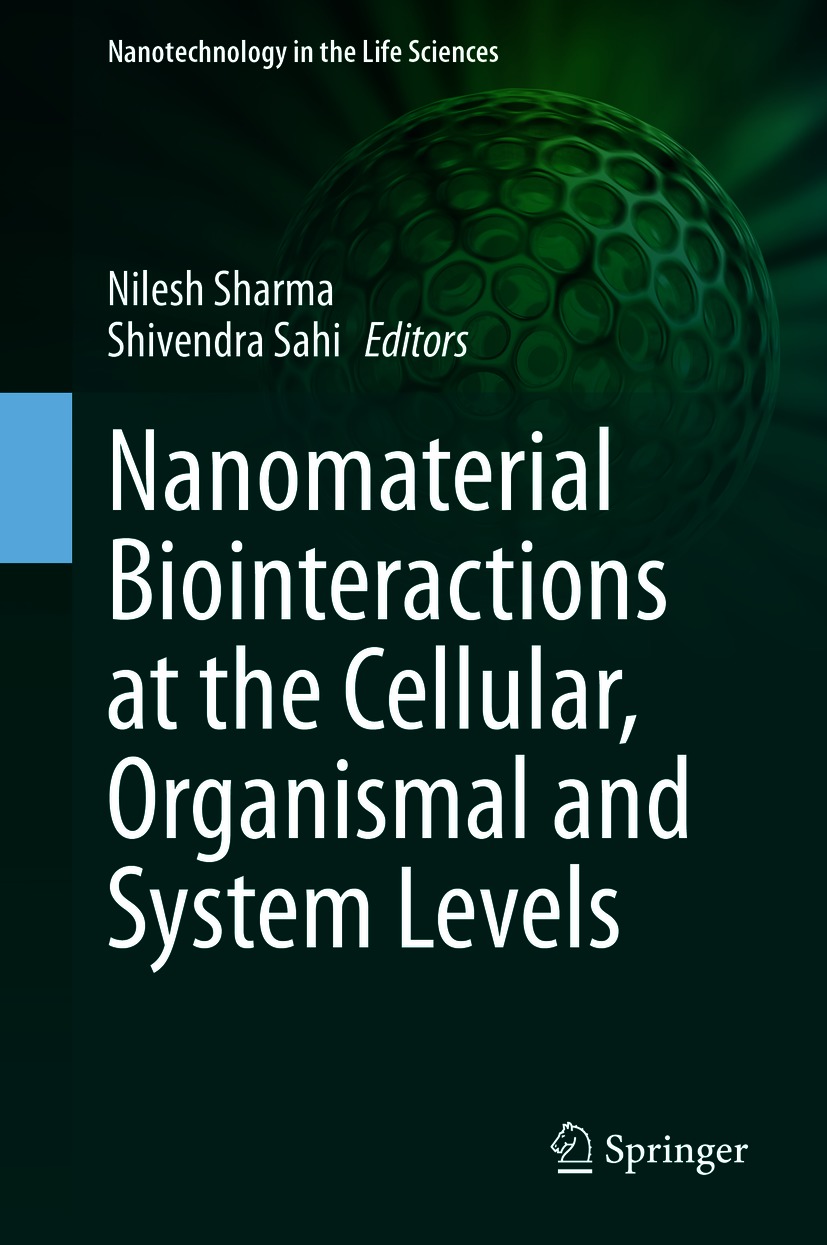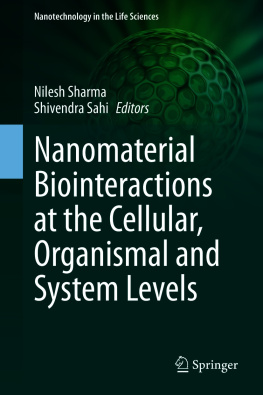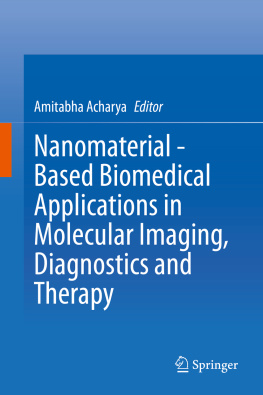Nilesh Sharma - Nanomaterial Biointeractions at the Cellular, Organismal and System Levels
Here you can read online Nilesh Sharma - Nanomaterial Biointeractions at the Cellular, Organismal and System Levels full text of the book (entire story) in english for free. Download pdf and epub, get meaning, cover and reviews about this ebook. publisher: Springer International Publishing, genre: Art. Description of the work, (preface) as well as reviews are available. Best literature library LitArk.com created for fans of good reading and offers a wide selection of genres:
Romance novel
Science fiction
Adventure
Detective
Science
History
Home and family
Prose
Art
Politics
Computer
Non-fiction
Religion
Business
Children
Humor
Choose a favorite category and find really read worthwhile books. Enjoy immersion in the world of imagination, feel the emotions of the characters or learn something new for yourself, make an fascinating discovery.
- Book:Nanomaterial Biointeractions at the Cellular, Organismal and System Levels
- Author:
- Publisher:Springer International Publishing
- Genre:
- Rating:5 / 5
- Favourites:Add to favourites
- Your mark:
- 100
- 1
- 2
- 3
- 4
- 5
Nanomaterial Biointeractions at the Cellular, Organismal and System Levels: summary, description and annotation
We offer to read an annotation, description, summary or preface (depends on what the author of the book "Nanomaterial Biointeractions at the Cellular, Organismal and System Levels" wrote himself). If you haven't found the necessary information about the book — write in the comments, we will try to find it.
Nilesh Sharma: author's other books
Who wrote Nanomaterial Biointeractions at the Cellular, Organismal and System Levels? Find out the surname, the name of the author of the book and a list of all author's works by series.
Nanomaterial Biointeractions at the Cellular, Organismal and System Levels — read online for free the complete book (whole text) full work
Below is the text of the book, divided by pages. System saving the place of the last page read, allows you to conveniently read the book "Nanomaterial Biointeractions at the Cellular, Organismal and System Levels" online for free, without having to search again every time where you left off. Put a bookmark, and you can go to the page where you finished reading at any time.
Font size:
Interval:
Bookmark:

Nano and biotechnology are two of the 21st centurys most promising technologies. Nanotechnology is demarcated as the design, development, and application of materials and devices whose least functional make up is on a nanometer scale (1 to 100 nm). Meanwhile, biotechnology deals with metabolic and other physiological developments of biological subjects including microorganisms. These microbial processes have opened up new opportunities to explore novel applications, for example, the biosynthesis of metal nanomaterials, with the implication that these two technologies (i.e., thus nanobiotechnology) can play a vital role in developing and executing many valuable tools in the study of life. Nanotechnology is very diverse, ranging from extensions of conventional device physics to completely new approaches based upon molecular self-assembly, from developing new materials with dimensions on the nanoscale, to investigating whether we can directly control matters on/in the atomic scale level. This idea entails its application to diverse fields of science such as plant biology, organic chemistry, agriculture, the food industry, and more.
Nanobiotechnology offers a wide range of uses in medicine, agriculture, and the environment. Many diseases that do not have cures today may be cured by nanotechnology in the future. Use of nanotechnology in medical therapeutics needs adequate evaluation of its risk and safety factors. Scientists who are against the use of nanotechnology also agree that advancement in nanotechnology should continue because this field promises great benefits, but testing should be carried out to ensure its safety in people. It is possible that nanomedicine in the future will play a crucial role in the treatment of human and plant diseases, and also in the enhancement of normal human physiology and plant systems, respectively. If everything proceeds as expected, nanobiotechnology will, one day, become an inevitable part of our everyday life and will help save many lives.
More information about this series at http://www.springer.com/series/15921

This Springer imprint is published by the registered company Springer Nature Switzerland AG
The registered company address is: Gewerbestrasse 11, 6330 Cham, Switzerland
Engineered nanomaterial applications have expanded from catalysis, electronics, and filtration to therapeutics, diagnostics, agriculture, and food because of the unique properties and potentials of different nanoparticles and nanomaterials, particularly belonging to metals. As the roles of nanomaterials are diversifying rapidly in every field cited above, the concern for their safety has also heightened in recent times. While novel applications emerge every year, research focusing on their unintended effects on living organisms and the natural environment that supports biota has also intensified. The available evidencefor and againstis strong, as it has been seen in every case of technological development. The solution thus lies in refining our knowledge and understanding the intricate modes of interactions that may occur between nanomaterials, organisms, and ecosystems. A fuller understanding sets conditions for the judicious application of technological innovation. Developing a holistic and balanced approach based on high-quality research may help to harness the full potential of nanotechnology in the twenty-first century.
Current research shows that nanoparticles can interact with an organism at the cellular, physiological, biochemical, and molecular levels. However, our knowledge of how they affect these changes, selectively or generally, locally or globally, in diverse organisms or ecosystems is very limited and far from satisfactory. Data indicates that the biological function largely depends on the concentration, shape, size, and surface characteristics of nanoparticles, as well as the cellular, genomic, and the epigenetic environments of the organism.
Therefore, this compilation focuses on the body of original work carried out by distinguished investigators using a range of nanomaterials and living organisms in different conditions. In the above backdrop, the book is organized in four parts: Part I containing chapters on interaction studies based on model organisms, Part II containing chapters on interaction studies based on plants (crop species) and agricultural systems, Part III containing chapters on interaction studies based on human cells and microbes, and Part IV containing chapters focusing on general mechanisms of interactions.
This collection includes specific case studies as well as general review articles highlighting aspects of multilayered interactions between nanomaterials and organisms and serves not only research and academic scholars but the concerned industry and policymakers as well. As this book presents the latest overview of the interface between nanomaterials and a variety of organisms, it can be ideal reference material for undergraduate or graduate-level courses in nanotechnology, nanotoxicology, or bionanotechnology.
We both acknowledge the contribution of the International Society of Trace Element Biogeochemistry (ISTEB) for hosting The International Conference on the Biogeochemistry of Trace Elements (ICOBTE) with a dedicated special section for the study of Nanomaterials: Applications & Impacts at ETH Zurich (Switzerland) in 2017. This was the occasion when the seed for the book was sown in discussions with the fellow researchers.
Font size:
Interval:
Bookmark:
Similar books «Nanomaterial Biointeractions at the Cellular, Organismal and System Levels»
Look at similar books to Nanomaterial Biointeractions at the Cellular, Organismal and System Levels. We have selected literature similar in name and meaning in the hope of providing readers with more options to find new, interesting, not yet read works.
Discussion, reviews of the book Nanomaterial Biointeractions at the Cellular, Organismal and System Levels and just readers' own opinions. Leave your comments, write what you think about the work, its meaning or the main characters. Specify what exactly you liked and what you didn't like, and why you think so.













